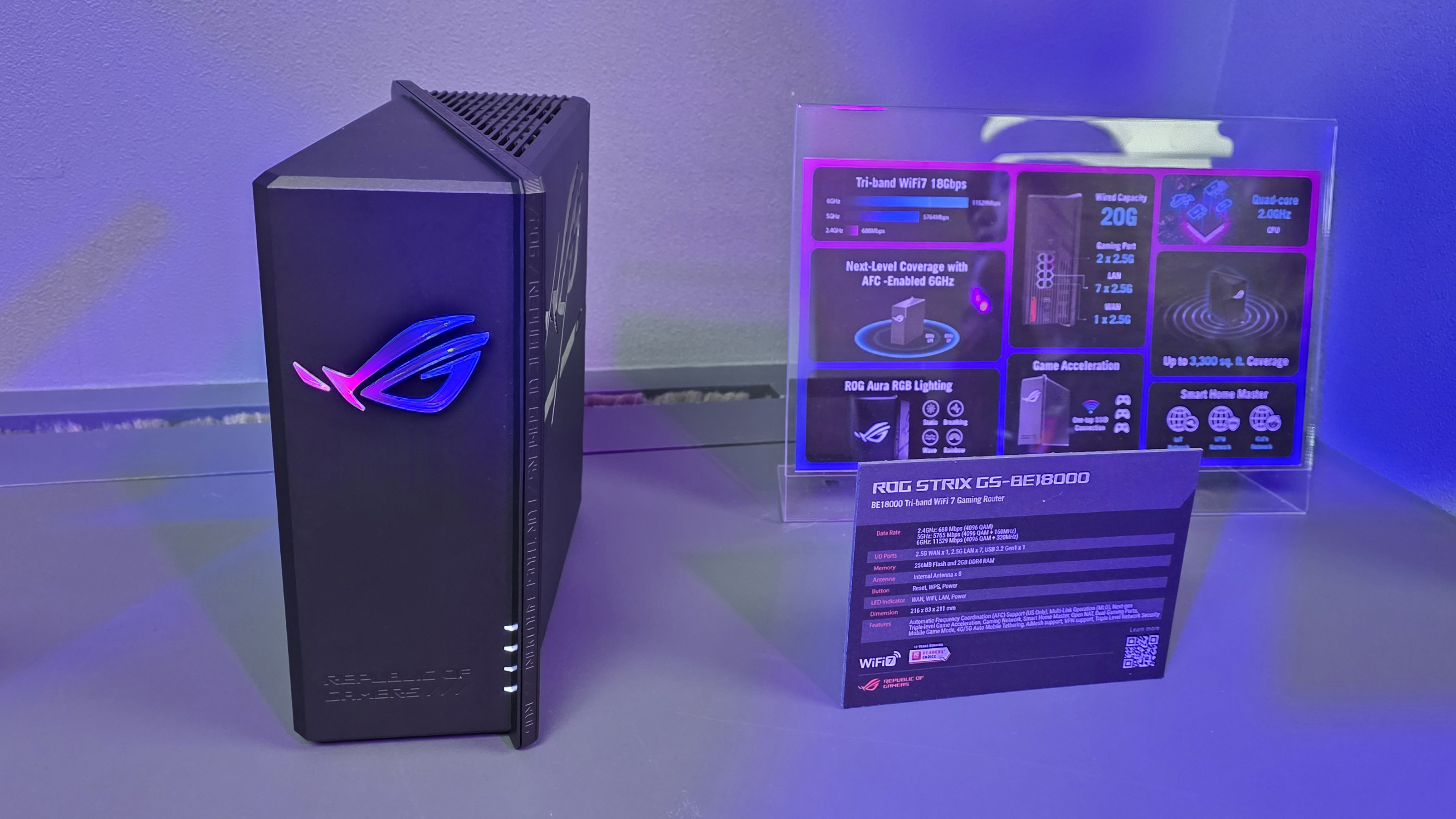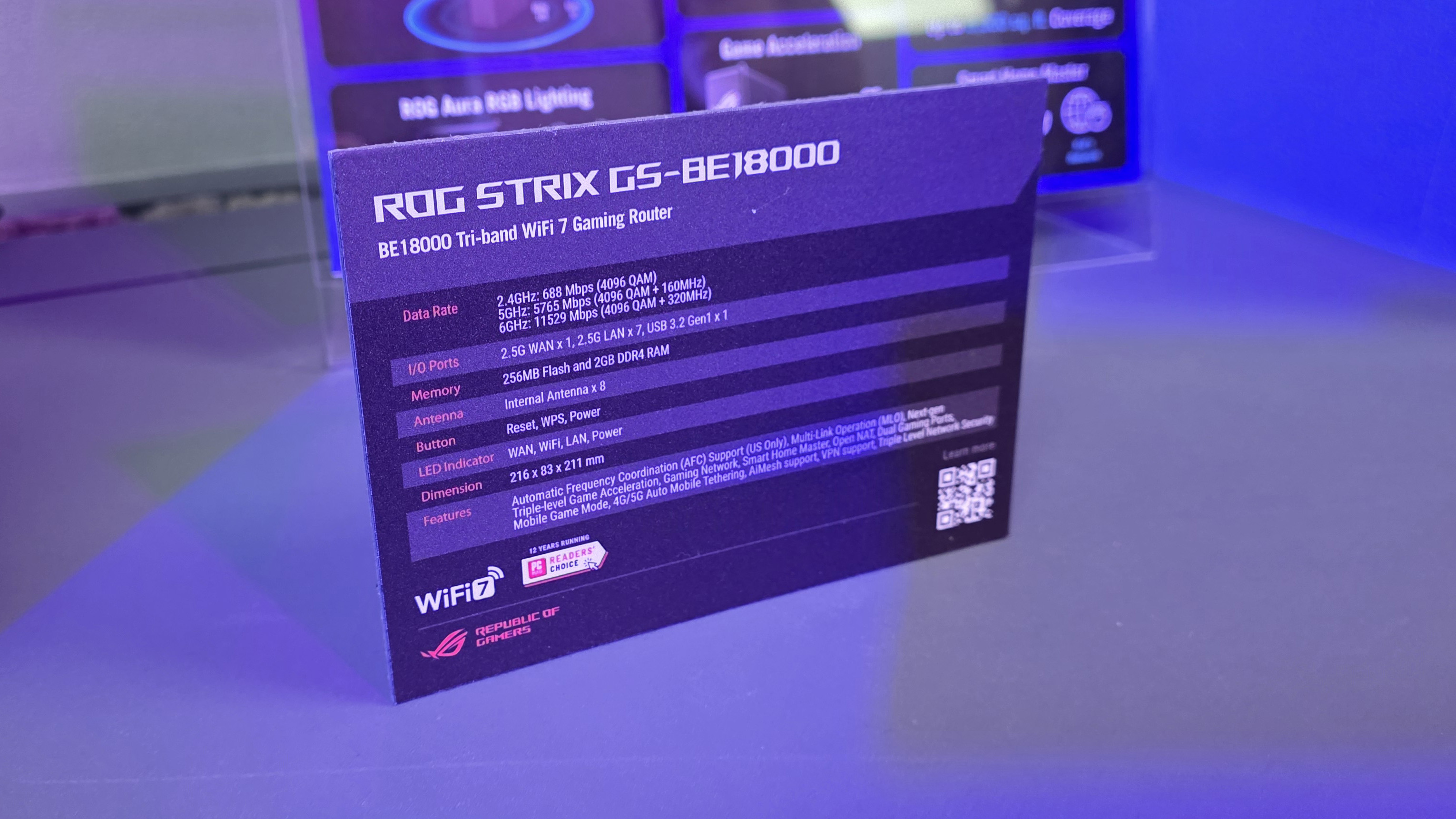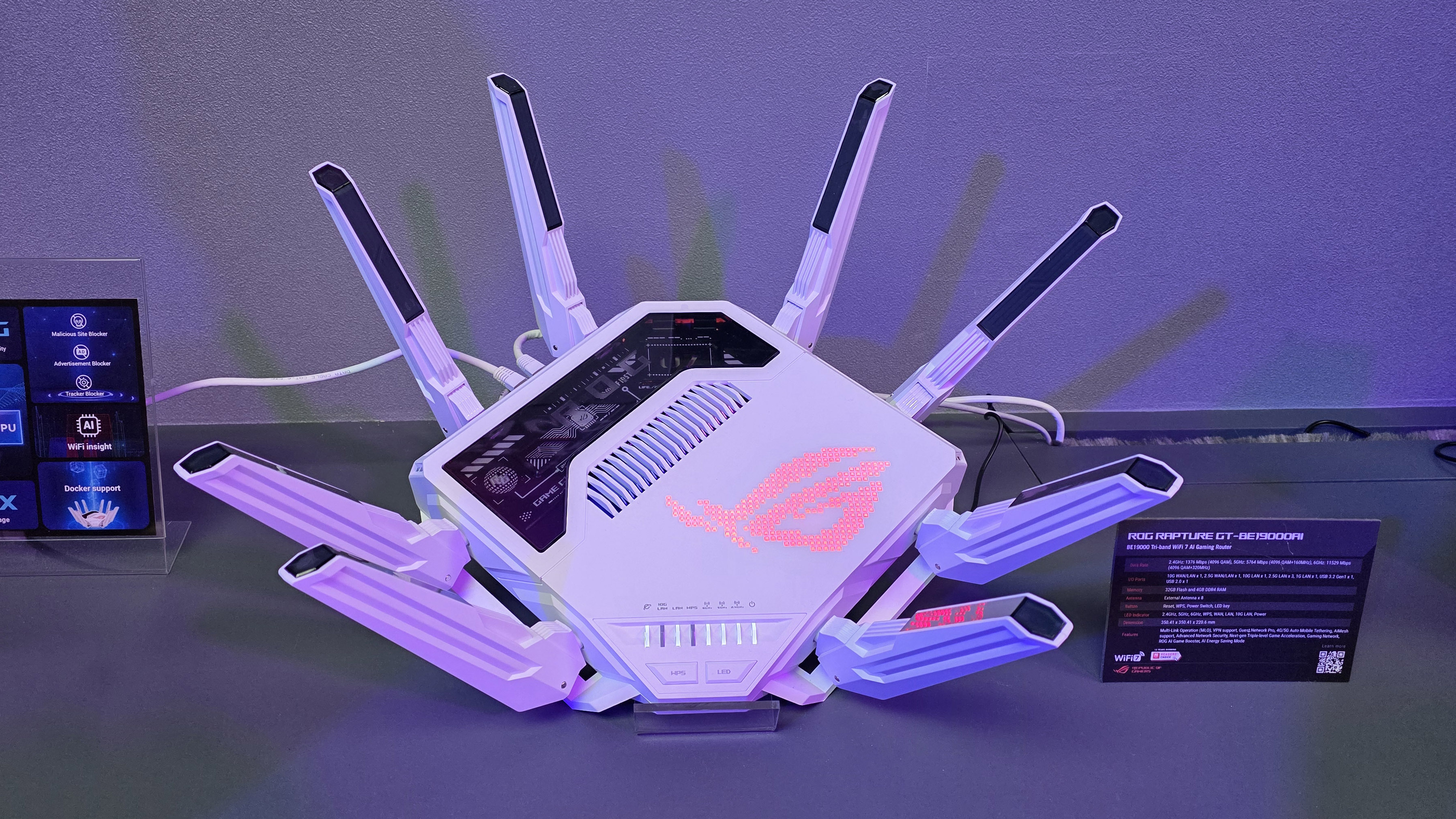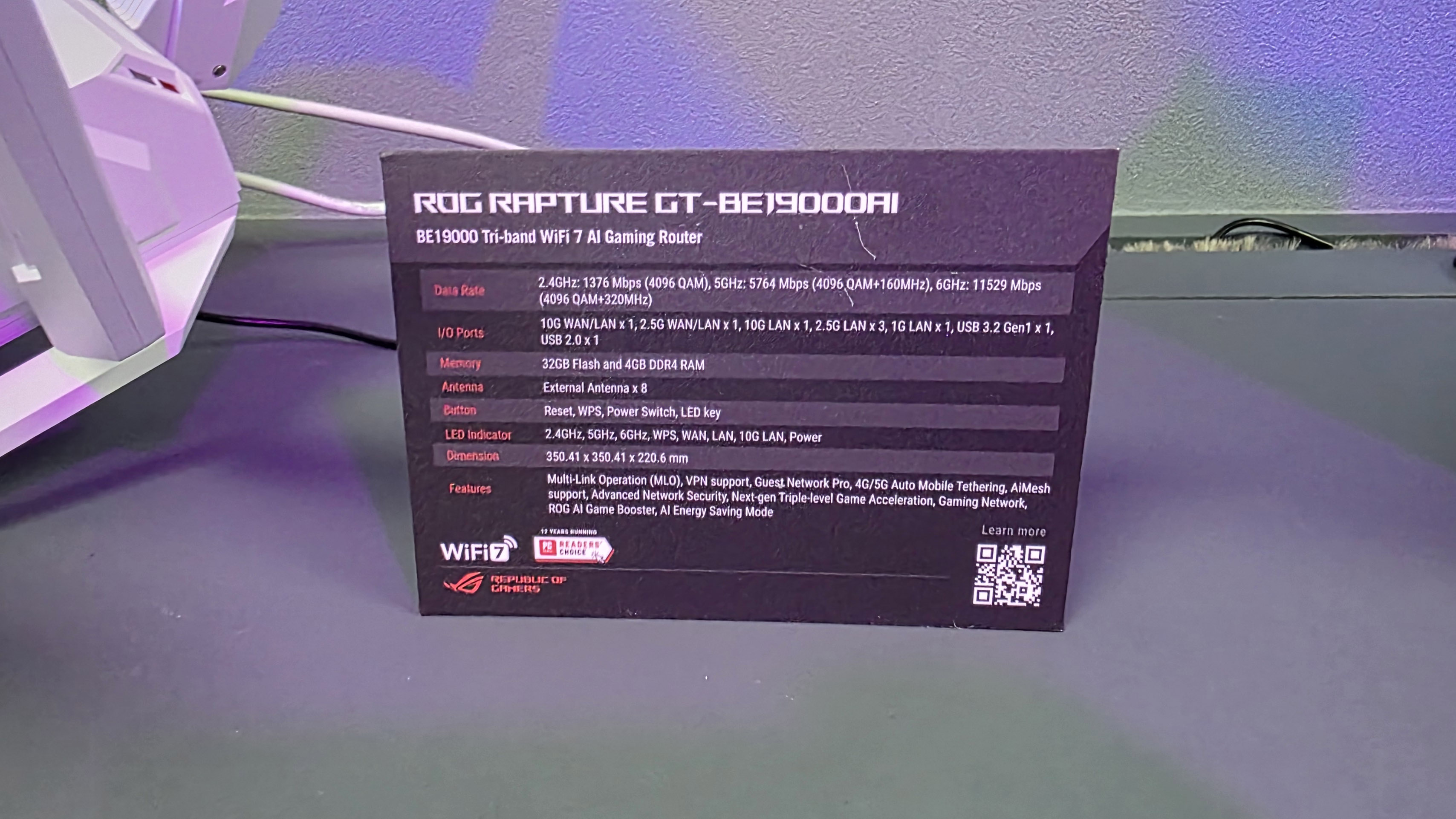Asus launches new ROG Wi-Fi 7 gaming router that comes with nine 2.5G ports
Enough bandwidth for a large LAN party

Asus has launched a premium Wi-Fi 7 router under its ROG (Republic of Gamers) lineup, packed with some interesting features. The new ROG Strix GS-BE18000 looks a lot like a gaming mini-PC tower laden with ROG branding and an RGB logo at the front, along with nine 2.5G ports. Announced at Computex 2025, the router was displayed alongside the ROG Rapture GT-BE19000AI, another high-end model featuring a sleek white design and AI capabilities thanks to a built-in Neural Processing Unit (NPU).
The ROG Strix GS-BE18000 router is meant for gamers, enthusiasts, or even a small office setup. It offers combined wireless speeds of up to 18 Gbps across the 2.4GHz (688 Mbps), 5GHz (5,765 Mbps), and 6GHz (11,529 Mbps) bands, and a total of 20 Gbps wired capacity, featuring nine 2.5G LAN ports out of which two are dedicated for gaming, along with a 2.5G WAN port.

The router is powered by a 2 GHz quad-core processor with 2GB of DDR4 memory to handle multiple connections and network tasks. It also includes eight internal antennas and features like traffic prioritization for gaming, Multi-Link Operation (MLO), 4G/5G auto mobile tethering support, pairing with other compatible mesh devices, triple-level network security, and offers coverage of up to 3,300 square feet.
Asus has also introduced an Automatic Frequency Coordination feature, which enables the 6 GHz frequency to go beyond LPI (Low Power Indoors) mode and boost the transmission power based on channel bandwidth to extend mid-to-long range coverage. Additionall,y the router includes carbon-nano-coated aluminum heat plates along with custom vents and heat spreaders to provide cooling to both sides of the internal mainboard.


The company also showcased the ROG Rapture GT-BE19000AI, which features an aggressive, high-tech design that’s clearly aimed at gamers and enthusiasts. The router sports a white hexagonal chassis with sharp, angular accents and is surrounded by eight large external antennas, giving the look of a sci-fi command hub or mechanical crown.
Announced first at CES in January, the Rapture GT-BE19000AI offers tri-band Wi-Fi 7 connectivity and features a built-in Neural Processing Unit (NPU) that is said to improve performance and efficiency. The router also offers wireless speeds of up to 19 Gbps and includes dual 10G ports, four 2.5G ports, and a 1G port, providing a total wired capacity of up to 31 Gbps.
Featuring a tri-core architecture comprising a CPU, NPU, and Microcontroller Unit (MCU), the router offers an AI-powered power-saving mode that is claimed to reduce energy consumption by up to 46% during periods of low activity. For gaming, the router offers AI Game Booster, which can optimize network real-time to reduce ping, jitter, and packet loss. It also features tools like VPN (Virtual Private Network), ad and tracker blockers, a network insight panel, and an RF scanner to enhance network stability and security.
Get Tom's Hardware's best news and in-depth reviews, straight to your inbox.
The router also supports five SSIDs through Guest Network Pro, allowing for network segmentation tailored to different devices or user groups. Additionally, it is compatible with the company’s AiMesh system for expanded network coverage.
Follow Tom's Hardware on Google News to get our up-to-date news, analysis, and reviews in your feeds. Make sure to click the Follow button.

Kunal Khullar is a contributing writer at Tom’s Hardware. He is a long time technology journalist and reviewer specializing in PC components and peripherals, and welcomes any and every question around building a PC.
-
kyzarvs Replynine 2.5G LAN ports out of which two are dedicated for gaming
Can we not call out such flimflam for what it is? This sort of stuff shouldn't go unchallenged. Show me a 'normal' switch that adds more than a fraction of a millisecond to ping. Show me a game than needs more than say 30mb to be competitive in (Flight Sim isn't competitive). -
AtrociKitty Reply
The gaming port is an SoC-level feature that mostly acts as QoS on a hardware level.kyzarvs said:Can we not call out such flimflam for what it is? This sort of stuff shouldn't go unchallenged. Show me a 'normal' switch that adds more than a fraction of a millisecond to ping. Show me a game than needs more than say 30mb to be competitive in (Flight Sim isn't competitive). -
Notton I'm not entirely sure who the RoG router is aimed at.Reply
4K/120hz remote play/moonlight anywhere in the house? -
bill001g More hype for stupid "gamers" who think they can pay to win by buying a router with the longest list of features they can find, none of which they actually understand.Reply
1. So called "competitive" gamers you would hope would know that you never play online games on wifi so any wifi features and all the fancy antenna mean nothing.
2. 2.5g makes no difference at all to online games. Most games use well under 1mbps so it will run the same as a router with 1gbit or even 100mbps ethernet ports.
3. So called gaming ethernet port is also stupid. This implies you are doing something stupid like downloading massive amounts of data from the intenet at the same time you expect performance on your game.
Even if we look at it as a non gaming router it is almost silly. All they basically did was add a 8 port 2.5g switch inside the router and charged much more than buying it yourself.
The wifi7 hype is the standard nonsense. They talk about all these fancy features and seem to neglect the fact that the router is only 1/2 the connection. The end device must also support these features. In many cases the router will drop back to the very common wifi5 that almost all portable still use.
The key feature that they jump up and down about and talk about massive transfer rates will likely never be implemented in any significate way is the bonding of the radios. The flaw in their argument is for this to even be used the end device must actually have mulitple radio chips to do the bonding with. This will greatly increase the price because you now must have 3 radio chips but much more significant is it takes up more physical board space and uses more power to run 3 radios rather than 1. Not likely to happen on cell phones and tablets which are the prime users of wifi. I have not even seen a add in PCIE board that has this ability for a desktop. It might exist but it is very rare....just like desktop pci nics with 4 antenna.
The one that gave me the biggest laugh was the marketing guys saying. " triple-level network security" Too technical for their little brains to call it WPA3 that has now been around for years and is a required feature on all equipment that is really wifi7 complient. And ignoring that WPA3 just changes the key exchange the actual encryption used is the same as other wifi standards.